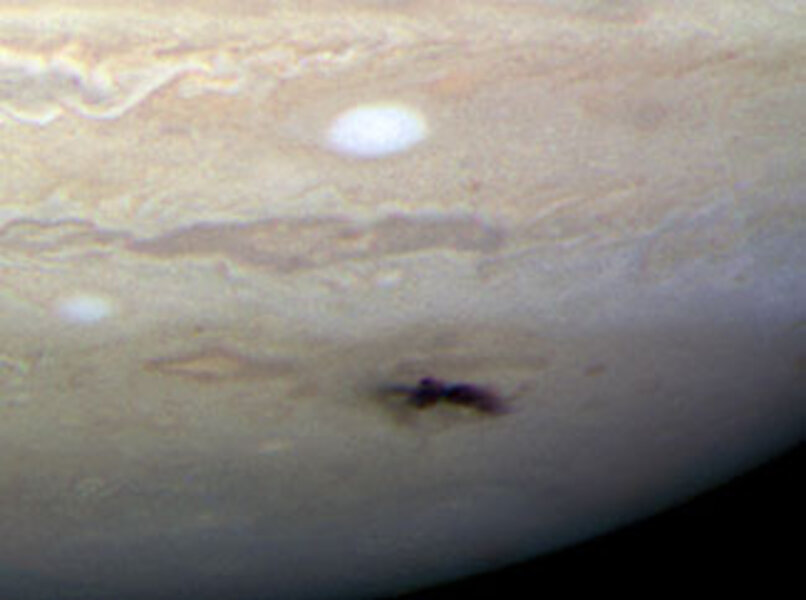Jupiter collision packed a huge wallop
Loading...
From mountaintop observatories on Earth to the Hubble Space Telescope, astronomers are eagerly tracking the evolution of a collision that appeared on Jupiter last weekend.
For planetary scientists who chronicled a comet's collision with Jupiter 15 years ago, the latest impact is an unexpected gift.
"It's an exciting time," says University of California at Berkeley astronomer Michael Wong. Dr. Wong and his colleagues pulled an all-nighter to capture and process images of the scar using the Hubble Space Telescope.
Initial estimates put the size of Jupiter's assailant at a few hundred yards across. When it hit Jupiter's upper atmosphere and exploded, it released thousands of times more energy than the oft-cited Tunguska explosion in Siberia in 1908, says Keith Noll, an astronomer at the Hubble Space Telescope Institute in Baltimore.
Recent estimates place the punch from the cosmic object that exploded over Tunguska at between 3 million and 5 million tons of TNT. That puts Jupiter's impactor into the continent-buster class.
It's not clear yet where the impactor came from. One likely source is the pool of short-period comets – icy objects that once resided beyond Neptune, but got pulled in toward the gas giants, notes Michael A'Hearn, a researcher at the University of Maryland.
Another possible source, he says, is a group of asteroids known as Trojans. These lie in two broad groups along Jupiter's orbit – one ahead of the planet, the other behind it.
One sign of the significance of an impact event is the speed with which astronomers drop what they are doing and train billions of dollars worth of hardware on the event.
Until the impact, for instance, technicians were putting Hubble through tedious-but-necessary tests after astronauts repaired and upgraded the observatory in May.
Astronomers tossed that schedule aside when they got word of the impact, and trained Hubble on Jupiter. Elsewhere, astronomers at the Keck and Gemini North telescopes on Hawaii's Mauna Kea volcano also elbowed to the head of the observing queue to follow the impact's aftermath.
Why all the hubbub? Astronomers cite several reasons, not the least of which is the possibility that these spectacular collisions between asteroids or comets and the solar system's giant planets may be more frequent than previously believed. They could occur on the order of once every few decades, rather than on century time-scales.
These events give astronomers a close look at the processes that formed the planets in the first place, says Berkeley's Dr. Wong. Small "planetesimals" collided with others, building ever-larger objects. Planet-building is still under way, although at a more glacial pace than earlier in the solar system's history.
Impacts also have much to teach about the planets they hit. In Jupiter's case, the object exploded in Jupiter's stratosphere, Dr. Noll says. By watching the pulverized object's remains spread, scientist can improve their understanding of the planet's atmospheric circulation.
The same holds true for atmospheric chemistry. Noll notes that the stratosphere contains carbon monoxide (CO), but there's no nearby source for the oxygen atom that CO contains. It's possible that impactors provide the oxygen, he says.
Jupiter's scar shows up as a bright streak when viewed at infrared wavelength. Another Berkeley astronomer, Paul Kalas, has noted that a Jupiter-like planet orbiting a star named Fomalhaut is also bright – perhaps a signal that it is being constant pummeled by smaller objects.





